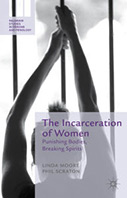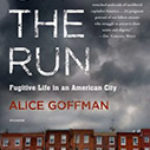The Incarceration of Women: Punishing Bodies, Breaking Spirits

Authors: Linda Moore and Phil Scraton
Publisher: Basingstoke, Hampshire, UK: Palgrave Macmillan, 2014. 256p.
Reviewer: Annie Rose Crowley | March 2016
International concern in recent years over the increasing number of imprisoned women has generated interest amongst academics, policy makers, campaigners and media alike. Yet the dominant focus continues to be on males, who make up the bulk of prison populations, and comparatively little is known about the gendered experiences of incarcerated women and girls. This book is a valuable and fascinating, albeit sobering, addition. It builds upon the previous work of its authors, Linda Moore (University of Ulster) and Phil Scraton (Queen’s University, Belfast), and that of others, particularly Mary Corcoran’s (2006) study of female political prisoners in Northern Ireland between 1972 and 1998. Moore and Scraton examine the effect of the conflict on the shaping of penal policy, and upon the treatment of all women prisoners, not just those held on political grounds. In doing so they explore how women’s gendered experiences of wider societal structures shape resistance and agency amongst those incarcerated. By including research and writing from other settings and academics, the authors situate the unique position of women in prison in Northern Ireland within a wider international context, drawing parallels and highlighting concerns.
The book is based upon a decade of research, enquiry and analysis, significantly ‘a period of political transition and conflict transformation in the North of Ireland’ (p. vi.). A Northern Ireland Human Rights Commissioner visit to the Mourne House Unit of HMP Maghaberry in 2003 raised concerns regarding the deterioration of the prison regime and conditions. The Commission then funded independent research to examine the extent to which the treatment of women and girls was compliant with international human rights law and standards. In-depth interviews, focus groups, observation and documentary analysis were conducted, first in Mourne House, and then in Ash House in Hydebank Wood after all women had been transferred there (currently Northern Ireland’s only custodial facility for women). Subsequent to these initial periods of study, the authors continued to conduct interviews with prisoners, analyse inspection reports and participate in reviews, and thereby track, document and analyse changes across the 10-year period.
A primary challenge for feminist scholars has been that of simultaneously seeking to understand, and advocate against the oppression of women. The stance of researchers Moore and Scraton, engaging in the debates and controversies taking place during their period of investigation, advances the understanding of how to rise to this challenge. I was struck by the persistence they demonstrated throughout the empirical work, and their commitment to bridging the outside-inside physical divide, to bear witness to ‘hidden micro-worlds’ (p.58). The words of women whose voices and agency have been silenced are woven into the fabric of the text. Through their testaments the reader understands the gravity of the situation, and the urgent need for change. This research is more than enquiry; it is a political act.
It would be possible to read Chapter One as a stand-alone introduction to the history of women’s imprisonment. It highlights key international developments from 1617, such as the achievement of gender segregation in prisons in different country settings. Attention is drawn to the steady global rise in women’s imprisonment, without an equivalent increase in frequency or seriousness of offending, and despite a commitment to the development of community alternatives. The authors outline the potential of prison regimes and powers to inflict pain, regardless of gender, age or ability, but introduce the particular gendered prison experiences of women, and the re-traumatising potential of the pains of physical, mental and emotional incarceration. The campaigns and aims of gender-specific reforms are also introduced, with acknowledgement of continuing barriers and conflicting aims.
Chapter Two explores notions of agency, resistance and protest within the context of the prison setting, and the boundaries imposed by structural and institutional relations and power. The point is raised that ‘it is no coincidence that incarceration […] is primarily class based’ (p.31), with the effects of structurally created inequalities seen outside of prisons mirrored and continuing to manifest inside of prisons. Goffman’s (1968) work is drawn upon to describe not only the ‘purposeful strategies adopted by regimes to isolate the prisoner and erode the value of self’ (p.38), but the strategies and ‘secondary adjustments’ made to negotiate and challenge authority, directly or indirectly. Of particular interest is the inclusion of existing work that notes similarities between the imprisonment of women, and abusive relationships, where exercising of agency and resistance to gendered norms can result in both contexts in ‘discipline, banishment, punishment and even death’ (p.53).
The methodology is introduced in the third chapter following a more general discussion regarding prison research. At first I found myself a little impatient to get to the actual research, but as I read on, the need to situate the narratives of the women’s experiences in this way within the narratives of security, control and access seemed significant. The multi-dimensionality of prison security is described: the physical control of freedom and movement, the practical control of time, and less visible controls such as freedom of information; and how these act to keep people (prisoners) inside, and others (including researchers) out. The difficulties and dilemmas of funding and access for prison research, and the extent to which such research can be truly critical and independent are explored. The power demonstrated in granting research access is demonstrative of the power between staff and prisoners, where staff have the capacity to exercise discretion in relation to any given situation. The authors state that there is a collective moral and political responsibility for those held in prisons, and that critical research is about asserting this right to know, whilst honouring a ‘Hippocratic’ prison research oath – to guard against harm and injustice to those who are made vulnerable through their involvement, whilst maintaining confidentiality. For researchers reading the book, there is a warning against unintended exploitation of prisoners by seeking their participation but never returning or sharing the outcome of the research.
The reader is invited to understand the subject of the research fully in its unique context. Chapter Four explains how imprisonment in Northern Ireland developed within a society and a criminal justice process emerging from a history of violent conflict and sectarian politics. Two key issues are highlighted: how the state’s institutional denial of the political motivations of Republican and Loyalist prisoners created persistent conflict within prisons, resulting in deterioration of regime and conditions and the development of a mind-set of non engagement with prisoners; and how the characterisation within prison discourse of ‘ordinary decent criminals’ contributed significantly to the isolation, stigmatization and neglect of prisoners without political affiliations. The authors demonstrate the Conflict’s continued legacy, and the persistent failure of the Northern Ireland Prison Service (NIPS) to generate significant reform. For example, during the Conflict, imprisonment was used as a tool to repress protest and rebellion, and effects of this remain: compliance being achieved through the silencing of resistance; acts of agency punished or at least limited in positive outcomes.
The following four chapters describe the research itself. The regime (and its deterioration), daily practice and management are covered in Chapter Five – Mourne House, and Chapter Eight – Ash House, the women’s ‘prison within’ the larger male Hydebank Wood prison. It is both unusual and valuable to find such a complete account of the minutiae and intricate workings of prison life. The detail illustrates how a regime and programmes not ‘overtly gender specific in design or delivery’ (p.126) resulted in gendered experiences of ‘regulation, control and punishments’, for example: delayed access to sanitary protection, punitive strip searches and inappropriate relationships between staff and prisoners. The 2002 and 2004 Her Majesty’s Inspectorate of Prisons (HMIP) and Criminal Justice Inspection Northern Ireland (CJINI) inspection reports are referenced, which respectively warn of a critical situation and of recommendations not followed. As a former researcher for HMIP who was part of the 2013 inspection of Ash House, this was of particular interest to me. I recognised both the constraints and time limitations placed upon those inspecting, as well as the real commitment and effort to document and act upon concerns and injustices.
The pathologisation discourse around women’s offending, and its influence in shaping prison regimes, with blurred boundaries between care and punishment, is outlined in Chapter Six. An example is the use of solitary conditions for those who self-harm, and case studies of women whose behaviour was deemed suicidal or self-harming, but whose only hospital facility was in the male prison. The chapter discusses the neglect of women with mental health issues, of failures of duty of care, inadequate training, and deficient emergency access procedures uncovered during the research. In sad progression, Chapter Seven uses case studies of women who committed suicide in Mourne House to explore the regulation of inquests by the European Convention of Human Rights (ECHR) and UN Standard Minimum Rules for the Treatment of Prisoners. The point is made that the NIPS reviews made minimal reference to the influence of gendered experiences, concluding that deaths were due to the complex psychiatric needs of the women.
In the empirical chapters we are given a glimpse into a world where institutionalised violence and injustice permit a neglect and marginalisation of the gendered needs and rights of the women sentenced to live there, in the words of the title, punishing their bodies and breaking their spirits. In these chapters, it is highly commendable and important that the authors bear witness to so many voices, and this is indeed an integral part of the feminist analysis. However, I found the volume of quotes and topics a little overwhelming without an indication of their direction, and felt subheadings could have been beneficial. At the same time, this can be understood as symbolic of the situation: that for women in prison, issues and priorities are multi-layered and complex, and do indeed overwhelm.
The final chapter returns the analysis to theoretical and political debate concerning the limits of prisoners’ agency and the consequences of resistance. Inspection, monitoring, Human Rights Legislations and Protections and external reports are also considered, and their findings and recommendations explored to evaluate progress since completion of the primary research. Through case studies, Moore and Scraton illustrate what they see as the failure of NIPS to acknowledge or effectively address deficiencies and rights abuses endemic in the system. This failing meant that the transition from prioritising political prisoners to meeting the very complex needs of ‘ordinary’ prisoners, did not fully take place. For example, the research focus covered breaches of the UN Convention on the Rights of the Child, as girls were being held in the women’s prison. The authors highlight that although by 2009 the NIPS had honoured the commitment to no longer hold those under the age of 18 in the adult women’s prison, no age-appropriate regime had been developed for the young women (18 – 21) held there. In the penal system where women are the minority, young women are the minority of that minority; as a researcher interested in the distinction of the needs and deeds of such younger women from those of older women, whilst it was good to see some concerns highlighted, I would have liked to have seen more reference to this. Regarding penal reform, the authors raise points about the limitations of a human rights framework for initiating change, and questioned both the potential and limitations of gender-specific policies. They highlight the potential for further development of community-based initiatives, and the case for abolition as an antidote to the continuing global expansion of women’s incarceration.
In conclusion, I found this to be an excellent and highly informative book. It includes a lot of material – historically, topically, empirically and theoretically – to tell several different but related and interlinked stories, and to campaign and to theorise. As such, it is a complex book, but fittingly, as it portrays a complex situation. It will be of great value to teachers and students of criminology and sociology alike, as well as to researchers in the field of penal research, and of relevance to policy makers and criminal justice practitioners. Through a gendered framework, one is given an understanding of the mechanisms by which penal institutions and practices are shaped and through which they transition, and how they are inspected and monitored. For those who are new to the topic of women and the criminal justice system, it offers a comprehensive and accessible exploration of both theory and facts related to incarceration. For those who are familiar with the area, the book advances some of the key theoretical issues through the lens of a unique and fascinating context. By including the experiences of women imprisoned internationally, it demonstrates scope for international comparison. Writing this review in Scotland a few months after the Scottish Government decided to scrap plans to build a new women’s prison, a proposal that had been criticised by some for being contrary to recommendations made in its own Commission for Women Offenders report (2012), I found the book’s illustration of the very real and human consequences of ignoring voices, findings and recommendations of research and inspections particularly relevant and significant.
References
- Corcoran, M. (2006) Out of Order: The Political Imprisonment of Women in Northern Ireland 1972 – 1998. Cullompton: Willan.
- Goffman, E. (1968) Asylums: Essays on the Social Situation of Mental Patients and Other Inmates. Harmondsworth: Penguin.
- Scottish Government (2012) Commission for Women Offenders. Final Report.
Annie Rose Crowley, Scottish Centre for Crime and Justice Research, University of Glasgow


